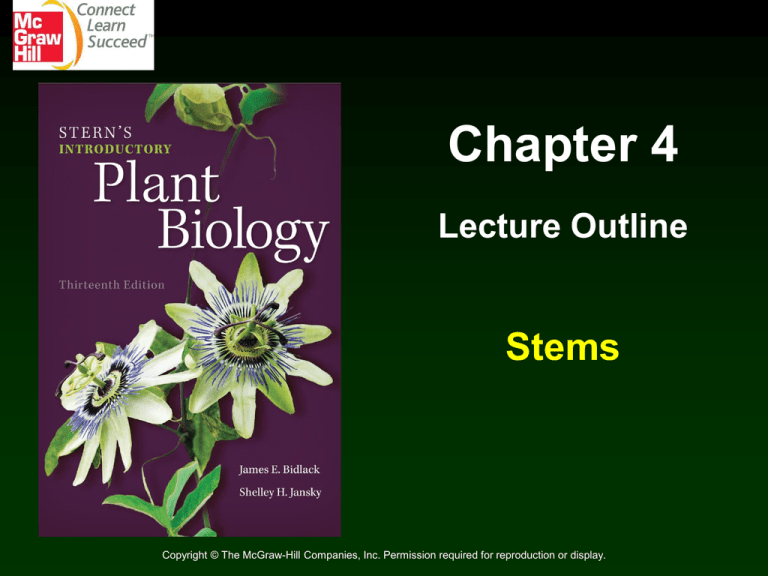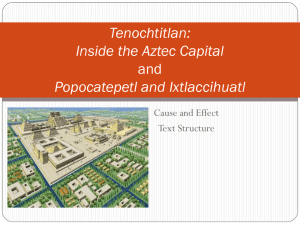Chapter 4
advertisement

Chapter 4 Lecture Outline Stems Copyright © The McGraw-Hill Companies, Inc. Permission required for reproduction or display. Outline External Form of a Woody Twig Origin and Development of Stems Tissue Patterns in Stems • Herbaceous Dicotyledonous Stems • Woody Dicotyledonous Stems • Monocotyledonous Stems Specialized Stems Wood and Its Uses External Form of A Woody Twig Cells produced by stem meristem become shoot system with branches and leaves. Woody twig consists of an axis with attached leaves. • Node - Area of stem where leaves are attached – Alternate or spiral – Opposite - Attached in pairs – Whorled - In groups of three or more • Internode - Stem region between nodes • Leaf has a flattened blade and is usually attached to the twig by petiole. External Form of A Woody Twig Axil - Angle between petiole and stem • Axillary Bud located in axil. – Will become branches or flowers in flowering plants – Bud scales protect buds. Terminal Bud at twig tip • Growth makes twig longer. • Number of groups of bud scale scars tells age of twig. Stipules - Paired, often leaflike appendages at base of a leaf External Form of A Woody Twig Deciduous trees and shrubs (lose all leaves annually) - After leaves fall, have dormant axillary buds with leaf scars below • Bundle scars mark food and water conducting tissue within leaf scars. Origin and Development of Stems Apical meristem at stem tip • Contributes to increase in stem length • Dormant before growing season begins • Protected by bud scales and by leaf primordia – Leaf primordia - Tiny embryonic leaves that develop into mature leaves Longitudinal section through stem tip Origin and Development of Stems Apical meristem cells form 3 primary meristems. • Protoderm - Gives rise to epidermis • Procambium - Produces primary xylem and phloem • Ground Meristem - Produces pith and cortex, both composed of parenchyma cells Longitudinal section through stem tip Origin and Development of Stems Leaf primordia and bud primordia develop into mature leaves and buds. • Traces branch off from cylinder of xylem and phloem, and enter leaf or bud. – Trace = strand of xylem and phloem – Each trace leaves a gap filled with parenchyma in the cylinder of vascular tissue, forming leaf gap or bud gap. Origin and Development of Stems Narrow band of cells between the primary xylem and primary phloem may become vascular cambium. • Cells produced by the vascular cambium become components of secondary xylem toward center and secondary phloem toward surface. Origin and Development of Stems In many plants cork cambium (phellogen) produces cork cells with suberin and phelloderm cells. • Function to reduce water loss and to protect stem against injury • Lenticels - Parenchyma cells in cork for exchange of gases Tissue Patterns in Stems Steles Stele - Central cylinder of primary xylem, primary phloem, and pith (if present) • Protostele - Solid core, phloem surrounds xylem – In primitive seed plants, whisk ferns, club mosses and ferns • Siphonosteles - Tubular with pith in center – Common in ferns • Eusteles - Discrete vascular bundles – In flowering plants and conifers Tissue Patterns in Stems Cotyledons - Seed leaves attached to embryonic stems • Store food needed by young seedling Dicotyledons (Dicots) - Flowering plants that develop from seeds having two cotyledons Monocotyledons (Monocots) - Flowering plants that develop from seeds with a single cotyledon Tissue Patterns in Stems Herbaceous Dicotyledonous Stems Annuals - Plants that die after going from seed to maturity within one growing season • Usually green, herbaceous plants • Most monocots are annuals, but many dicots are also annuals. • Tissues largely primary Tissue Patterns in Stems Herbaceous Dicotyledonous Stems Herbaceous dicots have discrete vascular bundles arranged in a cylinder. Vascular cambium arises between primary xylem and primary phloem. • Adds secondary xylem and secondary phloem Tissue Patterns in Stems Woody Dicotyledonous Stems Wood = Secondary xylem Differences in wood: • Vascular cambium and cork cambium active all year: – – Ungrained, uniform wood produced Some tropical trees • If wood produced seasonally: – – – In spring: Relatively large vessel elements of secondary xylem produced - Spring wood. After spring wood: Fewer, smaller vessel elements in proportion to tracheids and fibers - Summer wood. In conifers, vessels and fibers absent o Tracheids in spring larger than later in season Tissue Patterns in Stems Woody Dicotyledonous Stems One year’s growth of xylem = annual ring • Vascular cambium produces more secondary xylem than phloem. – Bulk of tree trunk consists of annual rings of wood. • Indicates age of a tree • Indicates climate during tree’s lifetime Vascular Rays consist of parenchyma cells that function in lateral conduction of nutrients and water. • Xylem Ray - Part of ray within xylem • Phloem Ray - Part of ray through phloem Tissue Patterns in Stems Woody Dicotyledonous Stems Cross section of young stem with secondary growth Tissue Patterns in Stems Woody Dicotyledonous Stems 3-D view of dicot wood Tissue Patterns in Stems Woody Dicotyledonous Stems Tyloses - Protrusions of adjacent parenchyma cells into conducting cells of xylem • Prevent conduction of water • Resins, gums, and tannins accumulate, and darken wood, forming heartwood. – Heartwood - Older, darker wood in center – Sapwood - Lighter, stillfunctioning xylem closest to cambium Tissue Patterns in Stems Woody Dicotyledonous Stems Softwood - Wood of conifers • No fibers or vessel elements Hardwood - Wood of dicot trees Resin canals - Tubelike canals scattered throughout xylem and other tissues • Lined with specialized cells that secrete resin • Common in conifers • In some tropical flowering plants – Frankincense and myrrh Resin canals in pine Tissue Patterns in Stems Woody Dicotyledonous Stems Bark - Tissues outside the vascular cambium, including secondary phloem • Mature bark may consist of alternating layers of crushed phloem and cork. Cross section of young stem with secondary growth Laticifers - Ducts found mostly in phloem that have latex-secreting cells • Rubber, chicle (chewing gum), morphine Tissue Patterns in Stems Monocotyledonous Stems Monocots stems have neither a vascular cambium nor a cork cambium. • Produce no secondary vascular tissues or cork • Primary xylem and phloem in discrete vascular bundles scattered throughout the stem – – Vascular bundles oriented with xylem closer to center of stem and phloem closer to surface. Parenchyma (ground tissue) surrounds vascular bundles. Cross section of monocot stem Tissue Patterns in Stems Monocotyledonous Stems In a typical monocot vascular bundle: • Two large vessels with several small vessels • First formed xylem cells stretch and collapse. – Leave irregularly shaped air space • Phloem consists of sieve tubes and companion cells. • Vascular bundle surrounded by sheath of sclerenchyma cells. Monocot vascular bundle Specialized Stems Rhizomes - Horizontal stems that grow below-ground and have long to short internodes • Irises, some grasses, ferns Runners - Horizontal stems that grow above ground and have long internodes. • Strawberry Stolons - Produced beneath the surface of the ground and tend to grow in different directions. • Potato Specialized Stems Tubers - Swollen, fleshy, underground stem • Store food • Potatoes - Eyes of potato are nodes Bulbs - Large buds surrounded by numerous fleshy leaves, with a small stem at lower end • Store food • Onions, lilies, hyacinths, tulips Specialized Stems Corms - Resemble bulbs, but composed almost entirely of stem tissue, with papery leaves • Store food • Crocus and gladiolus Cladophylls Flattened, leaf-life stems • Greenbriars, some orchids, prickly pear cactus Prickly pear cactus Wood and Its Uses In a living tree, 50% of the wood weight comes from water content. • Dry part of wood composed of about 60-75% cellulose and about 15-25% lignin. Density - Weight per unit volume Durability - Ability to withstand decay • Tannins and oils repel decay organisms. Wood and Its Uses Types of Sawing Radially cut (quartersawed) boards show annual rings in side view. Tangentially cut (plainsawed or slab cut) boards are cut perpendicular to rays. • Show annual rings as irregular bands of light and dark streaks Wood and Its Uses Knots - Bases of lost branches covered by new annual rings produced by the cambium Wood Products • About half of U.S. and Canadian wood production is used as lumber, primarily for construction. – – Sawdust and waste used for particle board and pulp. Veneer - Thin sheet of desirable wood glued to cheaper lumber • Pulp is second most widespread use of wood. – Paper, synthetic fibers, plastics, linoleum • In developing countries, about half of cut timber is used for fuel. – Less than 10% in US and Canada. Review External Form of a Woody Twig Origin and Development of Stems Tissue Patterns in Stems • Herbaceous Dicotyledonous Stems • Woody Dicotyledonous Stems • Monocotyledonous Stems Specialized Stems Wood and Its Uses










